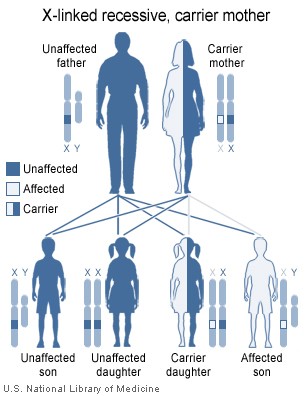Aarskog-Scott syndrome
| Aarskog-Scott syndrome | |
| ICD-10 | Q87.1 |
|---|---|
| ICD-9 | 759.89 |
| OMIM | 100050 |
| DiseasesDB | 29329 |
For patient information click here
Please Take Over This Page and Apply to be Editor-In-Chief for this topic: There can be one or more than one Editor-In-Chief. You may also apply to be an Associate Editor-In-Chief of one of the subtopics below. Please mail us [1] to indicate your interest in serving either as an Editor-In-Chief of the entire topic or as an Associate Editor-In-Chief for a subtopic. Please be sure to attach your CV and or biographical sketch.
Overview
Aarskog-Scott syndrome is an inherited disease characterized by short stature, facial abnormalities, skeletal and genital anomalies.
The Aarskog-Scott syndrome (AAS) is also known as the Aarskog syndrome, faciodigitogenital syndrome, shawl scrotum syndrome and faciogenital dysplasia.
Genetics

Aarskog-Scott syndrome is transmitted in an X-linked recessive manner. The sons of female carriers are at 50% risk of being affected with the syndrome. The daughters of female carriers are at 50% risk of being carriers themselves. Females may have mild manifestations of the syndrome. The syndrome is caused by mutation in a gene called FGDY1 in band p11.21 on the X chromosome.
Eponym
The syndrome is named for Dagfinn Aarskog, a Norwegian pediatrician and human geneticist who first described it in 1970,[1] and for Charles I. Scott, Jr., an American medical geneticist who independently described the syndrome in 1971.[2]
Description
The Aarskog-Scott syndrome is a disorder with short stature, hypertelorism, downslanting palpebral fissures, anteverted nostrils, joint laxity, shawl scrotum, and mental retardation. The physical phenotype varies with age and postpuberal males may have only minor remnant manifestations of the prepuberal phenotype.
Frequent features
- Growth
- mild to moderate short stature evident by 1-3 years of age
- delayed adolescent growth spurt
- Performance
- slight (dull normal) to moderate mental deficiency
- hyperactivity and attention deficit
- social performance usually good
- Face
- rounded face
- widow's peak hairline
- wide-set eyes (hypertelorism)
- droopy eyelids (blepharoptosis)
- downslanting eye slits (palpebral fissures)
- small nose with nostrils tipped forward (anteverted)
- underdeveloped mid-portion of the face (maxilla
- wide groove above the upper lip (broad philtrum)
- crease below the lower lip
- delayed eruption of teeth
- top portion (upper helix) of the ear folded over slightly
- Hands and feet
- small, broad hands and feet
- short fingers and toes (brachydactyly)
- in-curving of the 5th finger (clinodactyly)
- mild webbing between the fingers and toes
- single transverse "simian crease" in palm
- broad thumbs and big toes
- Neck
- short neck
- webbing of sides of the neck
- Chest
- mild pectus excavatum (sunken chest)
- Abdomen
- protruding navel
- inguinal hernias
- Genitalia
- Shawl Scrotum
- undescended testicles
Diagnosis
Genetic testing may be available for mutations in the FGDY1 gene. Genetic counseling is indicated for individuals or families who may carry this condition, as there are overlapping features with Fetal alcohol syndrome.[3]
Treatment
Surgery may be required to correct some of the anomalies, and orthodontic treatment may be used to correct some of the facial abnormalities. Trials of growth hormone have not been effective to treat short stature in this disorder.
Support Group
The MAGIC Foundation for Children's Growth is a support group for Aarskog-Scott syndrome and can be found at www.magicfoundation.org.
Prognosis
Mild degrees of mental slowness may be present, but affected children usually have good social skills. Some males may exhibit reduced fertility.
Complications
Some recent findings have included cystic changes in the brain and generalized seizures. There may be difficulty growing in the first year of life in up to one-third of cases. Misaligned teeth may require orthodontic correction. An undescended testicle will require surgery.
Molecular biology
The Aarskog-Scott syndrome is due to mutation in the FGD1 gene. FGD1 encodes a guanine nucleotide exchange factor (GEF) that specifically activates Cdc42, a member of the Rho (Ras homology) family of the p21 GTPases. By activating Cdc42, FGD1 protein stimulates fibroblasts to form filopodia, cytoskeletal elements involved in cellular signaling, adhesion, and migration. Through Cdc42, FGD1 protein also activates the c-Jun N-terminal kinase (JNK) signaling cascade, a pathway that regulates cell growth, apoptosis, and cellular differentiation.
Within the developing mouse skeleton, FGD1 protein is expressed in precartilaginous mesenchymal condensations, the perichondrium and periostium, proliferating chondrocytes, and osteoblasts. These results suggest that FGD1 signaling may play a role in the biology of several different skeletal cell types including mesenchymal prechondrocytes, chondrocytes, and osteoblasts. The characterization of the spatiotemporal pattern of FGD1 expression in mouse embryos has provided important clues to the understanding of the pathogenesis of Aarskog-Scott syndrome.
It appears likely that the primary defect in Aarskog-Scott syndrome is an abnormality of FGD1/Cdc42 signaling resulting in anomalous embryonic development and abnormal endochondral and intramembranous bone formation.
References
- ↑ Aarskog D (1970). "A familial syndrome of short stature associated with facial dysplasia and genital anomalies". J. Pediatr. 77 (5): 856–61. PMID 5504078.
- ↑ Scott CI (1971). "Unusual facies, joint hypermobility, genital anomaly and short stature: a new dysmorphic syndrome". Birth Defects Orig. Artic. Ser. 7 (6): 240–6. PMID 5173168.
- ↑ CDC. (2004). Fetal Alcohol Syndrome: Guidelines for Referral and Diagnosis. Can be downloaded at http://www.cdc.gov/fas/faspub.htm
Additional Resources
- Kenneth Lyons Jones: Smith's Recognizable Patterns of Human Malformation, 6th Edition (2005), WB Saunders, Philadelphia ISBN 072162359X
- Orrico A, Galli L, Cavaliere ML; et al. (2004). "Phenotypic and molecular characterisation of the Aarskog-Scott syndrome: a survey of the clinical variability in light of FGD1 mutation analysis in 46 patients". Eur. J. Hum. Genet. 12 (1): 16–23. doi:10.1038/sj.ejhg.5201081. PMID 14560308.
External links
- Faciogenital Dysplasia (Aarskog-Scott syndrome),detailed up-to-date information in OMIM (Online Mendelian Inheritance in Man)
- Images of clinical features of Aarskog-Scott syndrome
- [2]Pediatric Database Pedbase
- Template:WhoNamedIt
Template:Phakomatoses and other congenital malformations not elsewhere classified Template:SIB
de:Aarskog-Syndrom id:Sindrom Aarskog-Scott nn:Aarskogs syndrom fi:Aarskogin oireyhtymä sv:Aarskogs syndrom